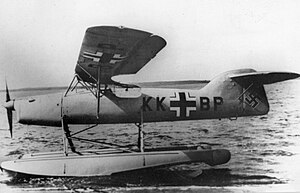
The Arado Ar 196 is a shipboard reconnaissance low-wing monoplane aircraft designed and produced by the German aircraft manufacturer Arado. It was the standard observation floatplane of the Kriegsmarine throughout the Second World War, and was the only German seaplane to serve throughout the conflict.

The Arado Ar 68 was a single-seat biplane fighter designed and produced by the German aircraft manufacturer Arado Flugzeugwerke. It was among the first fighters produced when Germany abandoned the restrictions of the Treaty of Versailles and began rearming.

The Arado Ar 240 was a German twin-engine, multi-role heavy fighter aircraft, developed for the Luftwaffe during World War II by Arado Flugzeugwerke. Its first flight was on 10 May 1940, but problems with the design hampered development, and it remained only marginally stable throughout the prototype phase. The project was eventually cancelled, with the existing airframes used for a variety of test purposes.
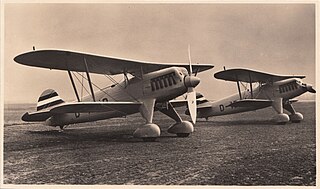
The Heinkel He 51 was a German single-seat biplane fighter aircraft. A seaplane variant and a ground-attack version were also developed. It was a development of the earlier He 49.

The Messerschmitt Bf 108 Taifun is a single-engine sport and touring aircraft designed and produced by the German aircraft manufacturer Bayerische Flugzeugwerke. It featured all-metal construction.

The Fairey Seafox was a 1930s British reconnaissance floatplane designed and built by Fairey for the Fleet Air Arm. It was designed to be catapulted from the deck of a light cruiser and served in the Second World War. Sixty-six were built, with two finished without floats and used as landplanes.
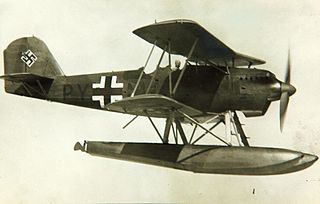
The Heinkel He 60 was a German single-engined biplane reconnaissance seaplane designed to be catapulted from Kriegsmarine warships of the 1930s.

The Heinkel He 116 was an extremely long-range mail plane designed and produced by the German aircraft manufacturer Heinkel.

The Yokosuka E14Y was an Imperial Japanese Navy reconnaissance seaplane transported aboard and launched from Japanese submarine aircraft carriers, such as the I-25 during World War II. The Japanese Navy designation was "Type 0 Small Reconnaissance Seaplane" (零式小型水上偵察機).
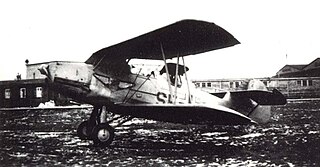
The Arado Ar 66 was a single-engined twin-seat training biplane designed and produced by the German aircraft manufacturer Arado. It was the last aircraft to be designed by the aeronautical engineer Walter Rethel in collaboration with Arado.
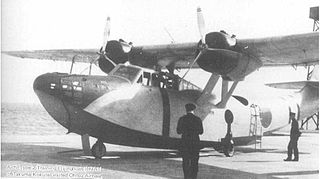
The Aichi H9A was an Imperial Japanese Navy Air Service flying boat used during the first years of World War II for crew training. An uncommon type, it was not encountered by Allied forces until Spring 1945 and was never assigned an Allied reporting name.

The Fieseler Fi 167 was a 1930s German biplane torpedo and reconnaissance bomber designed for use from the Graf Zeppelin class aircraft carriers under construction from 1936 to 1942.

The Arado Ar 197 was a German World War II-era biplane, designed for naval operations for the never-completed German aircraft carrier Graf Zeppelin. Only a few prototypes were built; the project was abandoned in favour of the Messerschmitt Bf 109T and Me 155.

The Arado Ar 95 was a single-engine reconnaissance and patrol biplane designed and produced by the German aircraft manufacturer Arado.

The Arado Ar 195 was a single-engine prototype carrier-based torpedo bomber, built by the German firm Arado for service on the German aircraft carrier Graf Zeppelin, during World War II.

The Arado Ar 76 was a German aircraft of the 1930s, designed as a light fighter with a secondary role as an advanced trainer in mind.
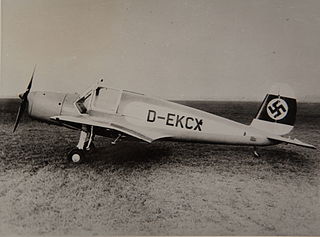
The Arado Ar 79 was an aerobatic two-seat trainer and touring aircraft designed and produced by the German aircraft manufacturer Arado. It was the final civilian aircraft developed by the company.

The Arado Ar 199 was a floatplane aircraft, built by Arado Flugzeugwerke. It was a low-wing monoplane, designed in 1938 to be launched from a catapult and operated over water. The enclosed cockpit had two side-by-side seats for instructor and student, and a third, rear seat, for a trainee-navigator or radio operator.
The Arado Ar 69 was a two-seat German beginner's school and sport biplane with an open cockpit, developed in 1933 by Arado Flugzeugwerke.
The Hirth HM 501 was a 6-cylinder air-cooled inverted in-line engine that was developed by Hirth Motoren GmbH in the late 1930s, from the 4-cylinder HM 500 and used principally on the submarine-born Arado Ar 231.
